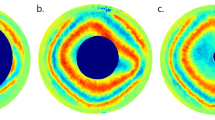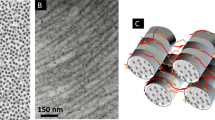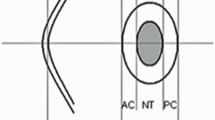Summary
The optical properties of fresh corneal lenses ofEphestia kühniella were investigated. The refractive index distribution in slices about 3 μm thick was measured with the interference microscope. An axial and radial variation was found, the radial distribution being symmetric to the lens axis. The lowest values (approx. 1.43) of the refractive index occur in the paraxial proximal region of the cone, while the highest values (approx. 1.54) are found at the distal boundary and the peripheral zone of the lens. This refractive index distribution is equivalent to that of a dispersive lens, whereas the convex corneal surface is a collecting lens of higher power.
This result is confirmed by experiments with the intact lens. The proximal distance between cornea and focal plane is +37.5 μm (Image mediumn = 1.335). This value and the geometrical properties of the lens give an effective lens refractive index of 1.40; this is lower than any value found in the cornea slices. If the convex curvature of the lens is optically compensated, the lens forms virtual erect images of an object.
Measurements of the central diffraction disc showed that the quality of imaging of the corneal lens is limited only by the lens aperture, and not by the refractive index distribution.
Zusammenfassung
Die optischen Eigenschaften unfixierter Cornealinsen vonEphestia kühniella wurden untersucht. Die Brechungsindexverteilung wurde interferenzmikroskopisch an ca. 3 μm dicken Schnitten gemessen. In der Cornealinse wurde eine kontinuierliche axiale und radiale Variation des Brechungsindex gefunden, die radiärsymmetrisch zur Linsenachse ist. Minima des Brechungsindex von ca. 1,43 liegen proximal im Achsenbereich der Linse, Maxima von ca. 1,54 an der distalen Linsenbegrenzung und im Randbereich. Diese Brechungsindexverteilung ist einer Zerstreuungslinse äquivalent, welche die sammelnde Wirkung der convexen Corneaoberfläche abschwächt.
In Übereinstimmung mit diesem Befund stehen Experimente, die an der intakten Linse durchgeführt wurden. Die proximale Brennpunktschnittweite der plankonvexen Cornealinse beträgt +37,5 μm (Bildraum,n = 1,335). Daraus ergibt sich ein effektiver Brechungsindex der Linse von 1,40. Dieser ist niedriger als alle in Corneachnitten gemessenen Werte. Ist die konvexe Außenfläche der Linse optisch kompensiert, entwirft die Cornealinse aufrechte, virtuelle Bilder eines Objektes.
Messungen der Größe des zentralen Beugungsscheibchens ergaben, daß die Abbildungsgüte der Cornealinse nur durch die Beugung am Linsenrand und nicht durch ihre Brechungsindexverteilung begrenzt ist.
Similar content being viewed by others
Literatur
Barlow, H. B.: Visual resolution and the diffraction limit. Science149, 553–555 (1965)
Exner, K.: Zur Linsenformel. Linsenwirkung nicht homogener Körper. Ann. Phys. Chem., N. F.28, 111–116 (1886 a)
Exner, K.: Gültigkeit der Linsenformel für nicht homogene Linsen. Ann. Phys. Chem. N. F.29, 484–487 (1886 b)
Exner, S.: Die Physiologie der facettirten Augen von Krebsen und Insecten. Leipzig-Wien: Franz Deuticke 1891
Fischer, A., Horstmann, G.: Der Fembau des Auges der Mehlmotte,Ephestia kühniella Zeller. Z. Zellforsch.116, 275–304 (1971)
Gahm, J.: Quantitative Messungen mit der Interferenzanordnung von Jamin-Lebedeff. Zeiss-Mitt.3, 3–31 (1963)
Hausen, K.: Die Brechungsindices im Kristallkegel der MehlmotteEphestia kühniella. J. Comp. Physiol.82, 365–378 (1973)
Horridge, G.A.: Alternatives to superposition images in clearzone compound eyes. Proc. roy. Soc. B179, 97–124 (1971)
Horridge, G.A.: Further observations on the clear zone eye ofEphestia. Proc. roy. Soc. B181, 157–173 (1972)
Kühn, A.: Entwicklungsphysiologische Wirkungen einiger Gene vonEphestia kühniella. Naturwissenschaften20, 974–977 (1932)
Kuiper, J.W.: The optics of the compound eye. Symp. Soc. exp. Biol.16, 58–71 (1962)
Kunze, P.: Eye glow in the moth and superposition theory. Nature (Lond.)223, 1172–1174 (1969)
Kunze, P.: Verhaltensphysiologische und optische Experimente zur Superpositionstheorie der Bildentstehung in Komplexaugen. Verh. Dtsch. Zool. Ges. Bd. 64, S. 234–238. Stuttgart: Gustav Fischer 1970
Kunze, P.: Comparative studies of arthropod superposition eyes. Z. vergl. Physiol.76, 347–357 (1972)
Kunze, P.: Pigment migration and the pupil of the dioptric apparatus in superposition eyes. In: Information processing in the visual systems of Arthropods (ed. R. Wehner), p. 89–92. Berlin-Heidelberg-New York: Springer 1972
Kunze, P., Hausen, K.: Inhomogeneous refractive index in the crystalline cone of a moth eye. Nature (Lond.)231, 392–393 (1971)
Meyer-Rochow, U. B.: The dioptric system of the eye ofCybister. Proc. roy. Soc. B183, 159–178 (1973)
Piller, H.: Durchlicht-Interferenzmikroskopie nach dem Jamin-Lebedeff-Prinzip. Zeiss-Mitt.2, 309–334 (1962)
Seitz, G.: Der Strahlengang im Appositionsauge vonCalliphora erythrocephala. Z. vergl. Physiol.59, 205–231 (1968)
Varela, F.G., Wiitanen, W.: The optics of the compound eye of the honey bee. J. gen. Physiol.55, 336–358 (1970)
Author information
Authors and Affiliations
Rights and permissions
About this article
Cite this article
Vogt, K. Optische Untersuchungen an der Cornea der MehlmotteEphestia kühniella . J. Comp. Physiol. 88, 201–216 (1974). https://doi.org/10.1007/BF00695407
Received:
Issue Date:
DOI: https://doi.org/10.1007/BF00695407




